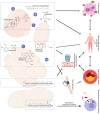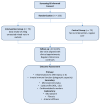Potential Health Benefits of Dietary Tree Nut and Peanut Enrichment in Kidney Transplant Recipients-An In-Depth Narrative Review and Considerations for Future Research
- PMID: 40806002
- PMCID: PMC12348535
- DOI: 10.3390/nu17152419
Potential Health Benefits of Dietary Tree Nut and Peanut Enrichment in Kidney Transplant Recipients-An In-Depth Narrative Review and Considerations for Future Research
Abstract
Kidney transplant recipients face a substantial burden of premature mortality and morbidity, primarily due to persistent inflammation, cardiovascular risk, and nutritional deficiencies. Traditional nutritional interventions in this population have either focused on supplementing individual nutrients-often with limited efficacy-or required comprehensive dietary overhauls that compromise patient adherence. In this narrative review, we explore the rationale for dietary nut enrichment as a feasible, multi-nutrient strategy tailored to the needs of kidney transplant recipients. Nuts, including peanuts and tree nuts with no added salt, sugar, or oil, are rich in beneficial fats, proteins, vitamins, minerals, and bioactive compounds. We summarize the multiple post-transplant challenges-including obesity, sarcopenia, dyslipidemia, hypertension, immunological dysfunction, and chronic inflammation-and discuss how nut consumption may mitigate these issues through mechanisms involving improved micro-nutrient intake (e.g., magnesium, potassium, selenium), lipid profile modulation, endothelial function, immune support, and gut microbiota health. Additionally, we highlight the scarcity of randomized controlled trials in high-risk populations such as kidney transplant recipients and make the case for studying this group as a model for investigating the clinical efficacy of nuts as a nutritional intervention. We also consider practical aspects for future clinical trials, including the choice of study population, intervention design, duration, nut type, dosage, and primary outcome measures such as systemic inflammation. Finally, potential risks such as nut allergies and oxalate or mycotoxin exposure are addressed. Altogether, this review proposes dietary nut enrichment as a promising, simple, and sustainable multi-nutrient approach to support cardiometabolic and immune health in kidney transplant recipients, warranting formal investigation in clinical trials.
Keywords: aging; dietary intervention; fibrosis; inflammation; kidney transplant recipients; micro-nutrients; nuts; oxidative stress; very long-chain saturated fatty acids.
Conflict of interest statement
Intersnack Nederland B.V. (Doetinchem, The Netherlands) is a nut supplier that will provide the necessary nut supply for conducting the planned intervention study. This project is further supported by means of a PPP-allowance, made available by the Top Sector Life Sciences & Health to stimulate public–private partnerships (project code: PPP2023-006). All financial support for this project was transferred to non-private/institutional accounts. The funders had no role in the study design, data collection, analysis, reporting, or the decision to submit for publication. The authors declare no other relevant conflicts of interest.
Figures


Similar articles
-
Prescription of Controlled Substances: Benefits and Risks.2025 Jul 6. In: StatPearls [Internet]. Treasure Island (FL): StatPearls Publishing; 2025 Jan–. 2025 Jul 6. In: StatPearls [Internet]. Treasure Island (FL): StatPearls Publishing; 2025 Jan–. PMID: 30726003 Free Books & Documents.
-
Synbiotics, prebiotics and probiotics for solid organ transplant recipients.Cochrane Database Syst Rev. 2022 Sep 20;9(9):CD014804. doi: 10.1002/14651858.CD014804.pub2. Cochrane Database Syst Rev. 2022. PMID: 36126902 Free PMC article.
-
Dietary Approaches to Stop Hypertension (DASH) for the primary and secondary prevention of cardiovascular diseases.Cochrane Database Syst Rev. 2025 May 6;5(5):CD013729. doi: 10.1002/14651858.CD013729.pub2. Cochrane Database Syst Rev. 2025. PMID: 40326569 Review.
-
Sex and gender as predictors for allograft and patient-relevant outcomes after kidney transplantation.Cochrane Database Syst Rev. 2024 Dec 19;12(12):CD014966. doi: 10.1002/14651858.CD014966.pub2. Cochrane Database Syst Rev. 2024. PMID: 39698949
-
Interventions for increasing immunosuppressant medication adherence in solid organ transplant recipients.Cochrane Database Syst Rev. 2022 Sep 12;9(9):CD012854. doi: 10.1002/14651858.CD012854.pub2. Cochrane Database Syst Rev. 2022. PMID: 36094829 Free PMC article.
References
-
- Kremer D., Alkaff F.F., Post A., Knobbe T.J., Tepel M., Thaunat O., Berger S.P., van den Born J., Genovese F., Karsdal M.A., et al. Plasma endotrophin, reflecting tissue fibrosis, is associated with graft failure and mortality in KTRs: Results from two prospective cohort studies. Nephrol. Dial. Transplant. 2022;38:gfac332. doi: 10.1093/ndt/gfac332. - DOI - PMC - PubMed
Publication types
Grants and funding
LinkOut - more resources
Full Text Sources

